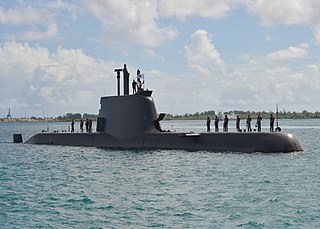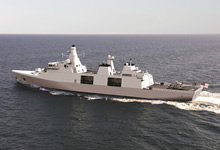Marconi Electronic Systems (MES), or GEC-Marconi as it was until 1998, was the defence arm of General Electric Company (GEC). It was demerged from GEC and bought by British Aerospace (BAe) on 30 November 1999 to form BAE Systems. GEC then renamed itself Marconi plc.

The Type 212A is a class of diesel-electric submarine developed by Howaldtswerke-Deutsche Werft AG (HDW) for the German Navy, and the Italian Navy where it is known as the Todaro class. It features diesel propulsion and an additional air-independent propulsion (AIP) system using Siemens proton exchange membrane (PEM) compressed hydrogen fuel cells. The submarines can operate at high speed on diesel power or switch to the AIP system for silent slow cruising, staying submerged for up to three weeks with little exhaust heat. The system is also said to be vibration-free and virtually undetectable.
BAE Systems plc (BAE) is a British multinational arms, security, and aerospace company based in London, England. It is the largest defence contractor in Europe, and ranked the seventh-largest in the world based on applicable 2021 revenues. As of 2017, it is the biggest manufacturer in Britain. Its largest operations are in the United Kingdom and United States, where its BAE Systems Inc. subsidiary is one of the six largest suppliers to the US Department of Defense. Other major markets include Australia, Canada, Japan, India, Saudi Arabia, Turkey, Qatar, Oman and Sweden, where Saudi Arabia is regularly among its top three sources of revenue. The company was formed on 30 November 1999 by the £7.7 billion purchase of and merger with Marconi Electronic Systems (MES), the defence electronics and naval shipbuilding subsidiary of the General Electric Company plc (GEC), by British Aerospace, an aircraft, munitions and naval systems manufacturer.

MBDA is a European multinational developer and manufacturer of missiles. It was created in December 2001 after the merger of the main French, British and Italian missile systems companies; Matra, BAe Dynamics and Alenia. These were previously the missile subsidiaries of Aérospatiale-Matra, BAE Systems and Finmeccanica. The company's headquarters are located in Le Plessis-Robinson, France.

Vickers Shipbuilding and Engineering, Ltd (VSEL) was a shipbuilding company based at Barrow-in-Furness, Cumbria in northwest England that built warships, civilian ships, submarines and armaments. The company was historically the Naval Construction Works of Vickers Armstrongs and has a heritage of building large naval warships and armaments. Through a complicated history the company's shipbuilding division is now BAE Systems Submarine Solutions and the armaments division is now part of BAE Systems Land & Armaments.

European multilateral defence procurement refers to the collective armaments purchasing policies of European nations.

ThyssenKrupp AG is a German industrial engineering and steel production multinational conglomerate. It is the result of the 1999 merger of Thyssen AG and Krupp and has its operational headquarters in Duisburg and Essen. The company claims to be one of the world's largest steel producers, and it was ranked tenth-largest worldwide by revenue in 2015. It is divided into 670 subsidiaries worldwide. The largest shareholders are Alfried Krupp von Bohlen und Halbach Foundation and Cevian Capital. ThyssenKrupp's products range from machines and industrial services to high-speed trains, elevators, and shipbuilding. Subsidiary ThyssenKrupp Marine Systems also manufactures frigates, corvettes, and submarines for the German and foreign navies.

The Dolphin class is a diesel-electric submarine developed in Israel and constructed by Howaldtswerke-Deutsche Werft AG (HDW) in Kiel, Germany, for the Israeli Navy. The first boats of the class were based on the export-only German 209-class submarines, but modified and enlarged. The Dolphin 1 sub-class is slightly larger than the German Navy Type 212 in length and displacement. The three newer air-independent propulsion (AIP) equipped boats are similar to the Type 212 vessels in underwater endurance, but are 12 metres (39 ft) longer, nearly 500 tonnes heavier in submerged displacement and have a larger crew than either the Type 212 or the Type 214.
Thales Underwater Systems or TUS is a subsidiary of the French defense electronics specialist Thales Group. It was created in 2001 and belongs to its naval division. It specializes in the development and manufacturing of sonar systems for submarines, surface warships and aircraft, as well as communications masts and systems for submarines. Its headquarters are located in Sophia Antipolis, France.

Howaldtswerke-Deutsche Werft is a German shipbuilding company, headquartered in Kiel. It is part of the ThyssenKrupp Marine Systems (TKMS) group, owned by ThyssenKrupp. The Howaldtswerke shipyard was founded in Kiel in 1838 and merged with Hamburg-based Deutsche Werft to form Howaldtswerke-Deutsche Werft (HDW) in 1968. The company's shipyard was formerly used by Friedrich Krupp Germaniawerft until the end of World War II.

The Type 214 is a class of diesel-electric submarines developed exclusively for export by Howaldtswerke-Deutsche Werft GmbH (HDW). It features diesel propulsion with an air-independent propulsion (AIP) system using Siemens polymer electrolyte membrane (PEM) hydrogen fuel cells. The class combines the design principles of the Type 209 submarine family and the features of the Type 212A submarine. However, as an export design, it lacks some of the classified technologies of the Type 212 such as the non-magnetic steel hull that makes it difficult to detect using a magnetic anomaly detector.

Saab Kockums AB is a shipyard headquartered in Malmö, Sweden, owned by the Swedish defence company Saab Group. Saab Kockums AB is further operational in Muskö, Docksta, and Karlskrona. While having a history of civil vessel construction, Kockums' most renowned activity is the fabrication of military corvettes and submarines.
Maschinenbau Kiel GmbH designed, manufactured and marketed marine diesel engines, diesel locomotives and tracked vehicles under the MaK brand name. The three primary operating divisions of Maschinenbau Kiel GmbH were sold to different companies in the 1990s.

The Canadian Surface Combatant, formerly the Single Class Surface Combatant Project is the procurement project that will replace the Iroquois and Halifax-class warships with up to 15 new ships beginning in the mid to late 2020s as part of the National Shipbuilding Procurement Strategy.
The German Naval Group is a consortium of German industrial companies that bid and won a major contract to design and build the New Generation Patrol vessels (NGPV) for the Royal Malaysian Navy.

ThyssenKrupp Marine Systems of Germany is a group and holding company of providers of naval vessels, surface ships and submarines. It was founded when large industrial conglomerate ThyssenKrupp acquired Howaldtswerke-Deutsche Werft on January 5, 2005.
Atlas Werke was a German shipbuilding company, located in Bremen. It was founded in 1911.

Boustead Heavy Industries Corporation Berhad, known for its subsidiary Boustead Naval Shipyard and often abbreviated as BHIC and BNS is a Malaysian industrial group specialised in naval and commercial shipbuilding as well as ship-related services. Its primary focus is shipbuilding, fabrication of offshore structures, as well as repair and maintenance of vessels and aircraft. The company is a public limited company and the largest shareholder is Lembaga Tabung Angkatan Tentera, a government statutory body which provides retirement benefits and a savings scheme for officers of the Malaysian Armed Forces, with a 58.69% stake. The second largest shareholder is Kumpulan Wang Persaraan, a company created by the Malaysian Government as an investment company, with a stake of 7.17%. The parent company is Boustead Holdings.

The Type 31 frigate or Inspiration class, and formerly known as the Type 31e frigate or General Purpose Frigate (GPF), is a planned class of frigate intended to enter service with the United Kingdom's Royal Navy in the 2020s alongside the submarine-hunting Type 26 frigate. Designed by Babcock International, it is also marketed under the name Arrowhead 140 and is based on Odense Maritime Technology's (OMT) Iver Huitfeldt-class frigate hull.
The Type 212CD class is a submarine class developed by ThyssenKrupp Marine Systems (TKMS) for the Norwegian and German navies. The class is derived from the Type 212 submarine class, but will be significantly larger than the 212 class.













